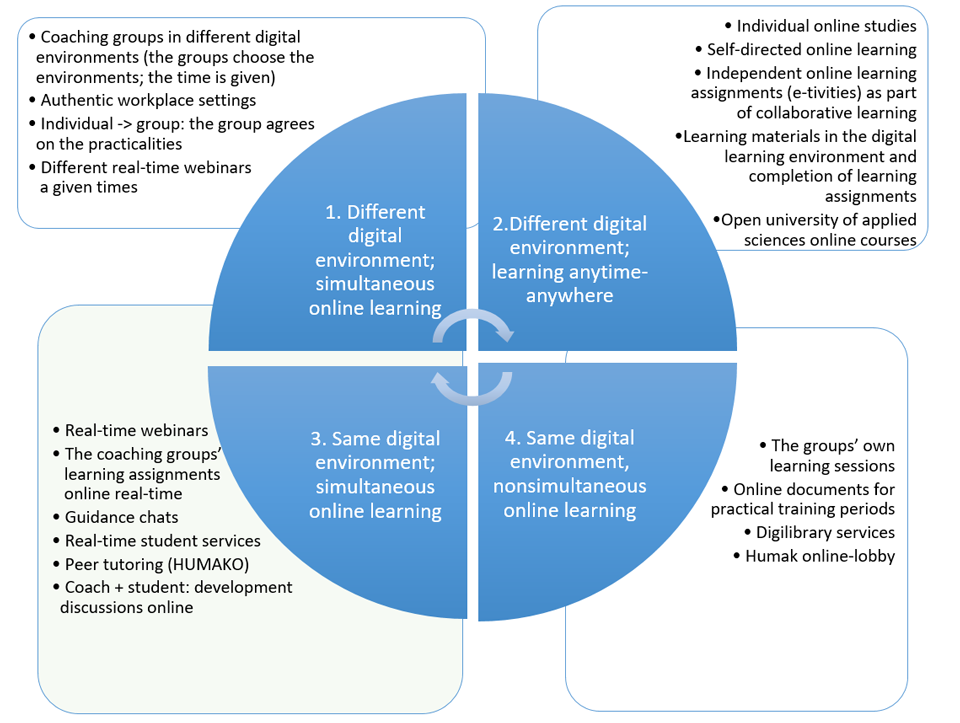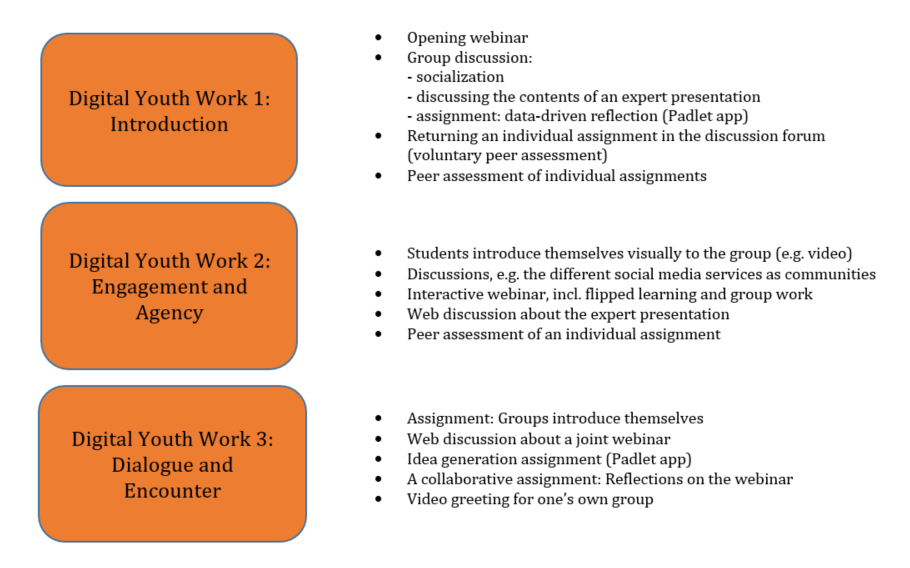
Sanna Ruhalahti, Markus Söderlund & Päivi Timonen
The data (n=324) for the article consist of a final survey, carried out for three different implementation groups with similar contents. The survey responses where studied qualitatively using the method of inductive content analysis. Worldwide, plenty of research on MOOC implementations has been conducted, but not much research has been done on collaborative learning on cMOOCs (Bozkurt, Akgün-Özbek, & Zawacki-Richter 2017). Moreover, in the field of continuing education within the Finnish higher education, cMOOCs are still relatively new, and no similar studies have been conducted.
Collaborative learning on open online courses
In this article, the process of collaboratively constructing knowledge online is approached from the socio-cultural viewpoint, and learning is seen as participation (Sfard 1998). The starting points are that knowledge is created and constructed collaboratively in a community and that learning is a social process (Vygotsky 1978; Lave & Wenger 1991). According to Gibson (2013), open learning environments offer students new opportunities to commit themselves to studying as part of collaborative learning communities and to learn from each other as well as to construct new knowledge; this, however, requires reciprocity and commitment to goal-oriented and shared activities (Resnick 1991; Byman, Järvelä, & Häkkinen 2005). According to Näykki, Järvenoja, Järvelä, and Kirschner (2015), in successful collaborative/community-based learning the group members are actively committed to contributing to the learning process. At its best, collaborative learning produces new knowledge and new skills.
Interactive technology is seen to facilitate collaborative learning and knowledge construction as well as increase commitment (Aarnio & Enqvist 2016). Engeström and Toiviainen (2011, 33) challenge learning designers to reflect on how to integrate the opportunities offered by deep learning outcomes, learning communities and technology. Collaborative/community-based pedagogy and a technical online learning environment that enables polychronic interaction support learning in coaching groups (Timonen 2014, 63–73). To be successful, digital coaching pedagogy requires a technical online learning environment where it is possible to learn in the same digital environment even at the same time. In this kind of a flexible digital learning environment, pedagogical objectives can be achieved in coaching groups. For students, the implementation environments of digital coaching pedagogy (picture 1) are explained through the dimensions different/same time/place. (Timonen 2016, 31–45.)

The figure above divides the places for digital learning into four sections, with collaboration and community as central elements in each. The question that follows is: How are the massive open online courses in digital youth work constructed with the elements of collaborative learning described above?
Massive open online courses facilitating collaborative learning
The abbreviation MOOC stands for a Massive Open Online Course. MOOCs are online courses run within continuing education, as a part of degree programs and they can be studied flexibly anywhere, anytime. (Paanan & Saari 2013.) The first MOOCs saw daylight at the turn of the millennium, when the Massachusetts Institute of Technology (MIT) started to transfer the learning materials of their courses into digital environments to make them available for all and then, in 2002, organized an open online course on information technology (Dufva & Nappu 2014). The words describing the modern online courses carry meaning: Firstly, openness refers to the fact that there are no eligibility requirements nor course fees for the participants. Secondly, they tend to be massive, as the number of participants is unlimited. Thirdly, the courses are run entirely online, and, finally, they are learning packages constructed with the principles of goal-oriented learning. (McAulay, Stewart, & Siemens 2010.)
MOOCs can be classified according to pedagogical process and way of implementation. One of the best-known models is cMOOC where learning is based on collaboration and community-driven learning activities (Haavind & Sistek-Chandler 2015; O’Toole 2013). In this article, the initial c refers to interactive learning that emphasizes community and collaboration in the learning activities. For instance, lectures and exercises are carried out traditionally as videos and texts, but the learners are expected to establish communities, to discuss the contents and, when it comes to exercises, give feedback to each other. (Grünewald et al. 2013.) According to Downes’ (2015) definition, cMOOCs contain deadlines, themes, materials and a digital platform for community-driven collaboration. The participants are expected to contribute to developing the theme of the course through collaboration and interaction. Indeed, Downes sees the implementations rather as online communities than actual courses. According to Means, Bakia, and Murphy (2014, 55) cMOOCs aim to develop the construction and understanding of knowledge within the learning communities through digital discussions and digital collaboration. Also Siemens (2014) emphasizes the significance of interaction on open online courses, as it often guarantees the experiences of achievement. According to Miller (2015) the cornerstones of a successful online course are an interactive learning community and the successful realization of interaction in three different relations: firstly, between the learner and learning contents, secondly, between the learner and the teacher, and, thirdly, among the learners. It is important to understand the opportunities of interaction and its significance in learning. In their new MOOC study, Ruhalahti, Korhonen, and Ruokamo (2016) state that in order to support collaborative learning, one needs to plan the learning processes carefully, to facilitate learning and to coach the students to collaborate.
For the cMOOCs discussed in this article, the background framework for planning the cMOOCs has been the coaching pedagogy of Humak University of Applied Sciences (see Sirkkilä 2015) applied to online environments. This pedagogical approach has been used in cMOOC implementations in a workplace-oriented manner with project partners: the universities of applied sciences and workplaces have established a pedagogical partnership for the project period, combining the expertise of the workplaces and the pedagogical expertise of the universities of applied sciences (Söderlund 2016). In the initiation phase of designing the collaborative online learning process, the theoretical basis has been the five-stage model developed by Salmon (2013; 2011), where the students proceed through the stages of motivation, socialization, information exchange and knowledge construction towards the stage of development. The cMOOC concept applied in the continuing education of digital youth work has been developed since 2014. In the initiation phase of the project, the contents, pedagogy, technical solutions and their revenue logic were studied and modelled. (Distanssi 2014; Korkalainen, Timonen, & Tuuttila 2014; Tähtinen 2014.)
The study and its context
The objects of the study were the three cMOOCs on digital youth work, each carried out with different contents in the spring of 2017 (Table 1). The study group consisted of one external researcher and two actors from the Distanssi project (coach, project manager). The data were collected by conducting a semi-structured final survey for the participants of the courses (n=324). The survey was conducted using the Webropol tool during the final week of each course, and responding to it was an obligatory course requirement.
Table 1. Data summary.
| DIGITAL YOUTH WORK 1: INTRODUCTION | DIGITAL YOUTH WORK 2: ENGAGEMENT AND AGENCY | DIGITAL YOUTH WORK 3: DIALOGUE AND ENCOUNTER |
|
|---|---|---|---|
| Participants | n=119 | n=119 | n=86 |
| Implementation period | 16/1/–12/2/2017 | 13/3/–9/4/2017 | 24/4/–21/5/2017 |
| Students who completed* / started** the course and the pass percentage | 125 / 163 = 77% | 120 / 143 = 84% | 87 / 108 = 81% |
*Students who completed the course, i.e. students who completed all the assignments of the cMOOC
** Students who started the course, i.e. all the students who responded the cMOOC initiation survey
Of those students who participated in the cMOOCs of this study, approximately 42 percent worked either with young people or in the youth work field, and almost as many studied either at a university of applied sciences, a university or on upper secondary level. Eighty-eight percent of the participants were women. The participants ’ age ranged from 18 to 63; only one of the participants was under 18 years old. A typical participants was 30–45 years old. The majority of the participants worked as a youth workers within municipal youth work. Three out of four participants participated in a MOOC for the first time. The average percentage for passing the different implementations was 80.
The theme for the first cMOOC implementation was An Introduction to Digital Youth Work. For the second course, the theme was Digital Engagement and Agency, and, for the third, Dialogue and Encounter (Figure 2). All courses were entirely carried out online. The members of the coaching groups were randomly selected with Moodlerooms group function, and the size of the group was usually 14–16 students. Sporadically, in some groups, there might have been more or less students than this, but the number was always less than 20. The coaches’ task was to follow the group’s progress, to participate in the discussions and, while doing so, to offer their own expertise related to the themes of digital youth work to the group. The other tasks for the coaches included encouraging the students and giving guidance when needed. With some particular assignments, the coach also assessed the students’ work. In the course introduction (either an opening webinar or a video record) of each course, the students were reminded of the collaborative and interactive nature of the course and the factors that usually facilitate collaborative learning and group action. Each cMOOC was an independent course, and the students could choose whether they would do one or several cMOOCs. Each course equaled 1 ECTS credit and lasted 4+1 weeks: the first 4 weeks were thematically divided into weekly assignments and the fifth week was reserved for supplementing the assignments. The students passed the course, when they had completed and passed all the assignments within five weeks. The cMOOC learning environments used were Blackboard Moodlerooms and the webinar environment Collaborate Ultra.

Those responsible for the cMOOCs were Humak University of Applied Sciences and Metropolia University of Applied Sciences. Their project partners were the National Centre of Expertise for Digital Youth Work in Finland (Verke) and the National Centre of Expertise for Youth Information and Counselling (Koordinaatti). Both partners took part in the planning and implementation of the course as well as the data production. (Distanssi n.d.)
The aim of the study was to answer the following questions:
a. What is the significance of coaching groups on cMOOCs?
b. Which factors facilitate collaboration and promote the sense of community on cMOOCs?
Data analysis
The data consisted of the open questions of the final survey carried out in the end of three different cMOOC implementations during the spring of 2017. The data was analyzed using the method of inductive content analysis (Schreier 2012), where the Atlas.ti program was used. The main emphasis in the inductive or data-driven content analysis lies on the data. This means that the units of analysis are not predefined, and the theory is constructed based on the data. Inductive content analysis requires simplification of the data and formation of concepts that reliably describe the matter at hand. Data quantification can be used to support content analysis, as it quantifies how many participants express a certain matter. (Schreier 2012.)
The research group studied the data carefully. The code categories were decided on together. Open respond contents were organized into categories that were based on the themes that arose from the data. The data were categorized applying the content analysis principle: matters with similar contents were included in the same category. The unit of analysis was a word, a sentence or a short expression. After the analysis, the code categorization was updated by combining classes with similar contents. The content analysis focused on identifying the significance and elements of collaborative learning and the factors that influence it on digital youth work cMOOC implementations.
Study results
What is the significance of coaching groups on cMOOCs?
Table 2 describes the code categories related to the students’ experiences of the significance of the coaching group in collaborative learning. The results indicate that the significance of the coaching group as part of collaborative learning was considered important.
Table 2. Students’ experiences of cMOOCs related to the significance of coaching groups (f=245).
| CODE CATEGORY | OCCURRENCE (F) |
|---|---|
| New viewpoints | 70 |
| Peer learning | 46 |
| Sharing information and experiences | 33 |
| Encouragement and feedback | 22 |
| Developing one’s knowhow | 16 |
| Commitment | 7 |
| Minor significance | 51 |
Finding new viewpoints and bringing them into the collaboration of the coaching group was found very important. Reading and commenting the group members’ views was found significant by the participants. It was also mentioned that the group consisted of multi-skilled persons, and bringing out one’s own viewpoints made co-learning richer. Many participants expressed that digital environments and using them had given new tips for their own work.
”It was positive that there were people with different backgrounds; there were students, there were graduates from different disciplines, people working in different fields, people in different ages and from different areas. A mixed group was great. It was possible to gain new and different insights.”
Peer learning came up in the analysis, especially from the viewpoint that belonging to the coaching group was important. Peer support and peer-to-peer activities attached a feeling of security to the studies as they enabled a low-threshold human contact and gave courage to ponder unclear things. Peer learning gave a feeling of belonging to the community. The heterogeneity of the group increased the significance of peer learning.
”And even though I was doing the course physically alone in my own living room, I had a feeling that here we are, learning together!”
Based on the analysis, the sharing of information and experiences widens the development of the coaching group’s knowledge and skills. The heterogeneity of the groups, mentioned above, effectively enabled the sharing of existing knowledge and experience in a digital environment. Experiences were shared about the use of different digital applications in the field of youth work, and they were keenly discussed in the coaching group. Especially the youth work students found the working course participants’ practical know-how beneficial.
”Sharing knowhow and experiences within the coaching group was a very interesting adjunct to the course.”
Moreover, the course participants’ support and feedback to each other supported collaborative learning in the coaching groups. Feedback was found important; it was seen to develop one’s own knowhow and understanding.
”The coaching group encouraged to study the subjects and gave hope and strength to carry on, and gave straightforward hints and tips.”
The coaching group was considered significant in developing one’s own knowledge and skills. “Through the coaching group, it was possible to picture one’s own skills and targets for development. The assignment where we had to share well-tried digital tools was extremely useful. I became familiar with many tools.” Belonging to the coaching group added a feeling of commitment to the studies; this, again made the students want to keep up with the group’s schedule: “A motivator, or a social arm-twister, but in a good way!”
It needs to be said, though, that some of the students found the coaching group less significant or insignificant. Reasons for this included the will to study according to one’s own schedule, lack of time, and the incapability of the coaching group to function as well as other personal interests.
Which factors facilitate collaborative learning on cMOOCs?
Collaborative learning was promoted especially by participation, interaction skills and commitment to the community-driven learning process. The quantitative results of the inductive analysis of the open responds given by the three cMOOC implementation groups are presented in Table 3.
| CODE CATEGORY | OCCURRENCE (F) |
|---|---|
| Participation | 104 |
| Interaction | 55 |
| Commitment | 46 |
| Resourcing the time | 22 |
| Collaborative learning | 20 |
| Having the courage to | 13 |
| Motivation | 4 |
| Other | 3 |
The students found active participation in the coaching group the most important pillar of collaborative learning. It was considered very important that all participate in collaborative learning. The students hoped that the students’ activity would show especially as sharing experiences and knowledge through participation in the discussions and also through commenting. Moreover, reflecting on one’s own actions was brought forward in the responds, as well as the fact that the students should themselves have actively participated in the coaching group’s activities.
”Every participant’s active and spontaneous participation, as well as assignments that guide students towards shared activities.”
When it came to mastering interaction skills, especially operating in the online environment was emphasized in the answers. According to the responds, collaborative learning was facilitated if the participants were able to express themselves in writing on the coaching’s groups own working forum. Other facilitating factors mentioned were the participants’ abilities to act reciprocally, to listen and concentrate and to give constructive feedback. With reciprocity, it was considered especially important to respect the other participants’ opinions and experience and to be heard. Also trust and encouragement within the coaching group were mentioned.
”Reciprocity, listening, being heard, sharing, positive encouragement.”
Commitment to a shared process and common assignments contributes positively to learning. Commitment to the deadlines and schedules and sticking to these help the coaching group keep up with the learning process. Each participant’s efforts were considered important and, in practice, this was seen as presence at the course assignments that facilitated collaborative learning.
”Roll up your sleeves attitude from everyone as well as commitment to the schedule and the assignments.”
Collaborative learning on cMOOCs requires resourcing the time. Both with individuals and with coaching groups, learning was seen to require more accurate time management. Time was needed for familiarizing with the assignments and for coming back to the community’s discussions over and over again.
Collaborative learning requires assignments that support it. Based on the responds, participants wished for more assignments that support collaboration. Assignments that support the formation of the community were seen to promote the sense of community, the collaboration and the group process. The participants experienced that the learning atmosphere improves with team spirit.
”More community-driven assignments that require collaboration.”
According to the students, having the courage to operate in the cMOOC online environment was important.
This could be seen in the joint webinars as courage to take the floor and to write one’s own thoughts and opinions on the coaching group’s own working forum. Courage to bring up subjects and to face new challenges within digital youth work were also mentioned.
”The courage to write one’s own views without having to fear that they will be slammed.”
Reflection
The objective of this article was to produce new knowledge of the digital youth work cMOOC implementations and to explore the significance of coaching groups in collaborative learning. Another objective was to study which factors facilitated collaborative learning in these three cMOOC implementations.
The results indicate that learning in coaching groups brought forward new viewpoints and enabled the sharing of thoughts and views in a multidisciplinary community, which gave new knowhow on digital youth work for one’s own daily work (see Gibson 2013). Sharing knowledge and experience succeeded well in the cMOOC environment, which supports the research results of Mean, Bakia, and Murphy (2014). Also the experience of peer learning was, based on the results, one of the most important strengths of studying with a coaching group. Peer learning was the main factor that remarkably contributed to the sense of community. The encouragement and feedback given by other community members were considered significant. Based on the results of this study, it can be stated that the coaching group is significant as it contributes to one’s skills development and as the group mirrors one’s own self-reflection on skills development. However, the results also indicate that a part of the participants found the coaching groups less significant or even insignificant.
Active participation in the coaching group was considered the most important factor that contributes to collaborative learning. This is also in line with the results of Näykki et al. (2015). Especially mastering online communication and interaction skills was found to facilitate implementations based on collaborative learning (see Aarnio & Enqvist 2016; Miller 2015; Siemens 2014). The commitment of all coaching group members and resourcing the time were seen to facilitate the community’s collaboration. According to the results, increasing the number of community-driven assignments that support collaboration is an important factor. Moreover, courage to operate in the online environment and in the field of youth work development was found a significant factor in collaborative learning. These results are in line with the previous MOOC study: actions that support the elements of collaborative learning in the learning process are to be reinforced through coaching and designed learning processes (see Ruhalahti, Korhonen, & Ruokamo 2016).
The authors of this article have aimed to increase its reliability by systematic data collection, analysis and reporting. In the study group, the roles of implementation designer, coach and external researcher were combined in order to avoid selective interpretations of the results. The transparency of the analysis was reinforced by collaboration and careful coding.
More studies are needed on collaborative learning on open online courses. It would be interesting to study the significance of the coach as a part of the coaching group’s actions and especially the instruction of collaborative learning.
The elements of collaborative learning to accomplish a shared assignment and to achieve a common goal are empowering factors also on digital youth work cMOOCs. To achieve a common goal, collaborative learning requires a community and commitment to it.
This article was produced as part of the Distanssi project, financed by the Finnish Ministry of Education and Culture.
This article was originally published as Yhteisöllisen oppimisen opiskelijakokemuksia digitaalisen nuorisotyön cMOOCeissa in Finnish in April 2018.
Authors

Sanna Ruhalahti educates teachers at Häme University of Applied Sciences (HAMK) and works on her Ph.D. at the University of Lapland. Her Ph.D. studies concentrate on the dialogical community-driven knowledge construction in open learning environments.

Markus Söderlund is Senior Lecturer and the project manager of the Distanssi project at Humak University of Applied Sciences.

Päivi Timonen is Senior Lecturer and online learning specialist at Humak University of Applied Sciences. She is a pioneer in the field of digital youth work and an online learning expert.
References
Aarnio, H. & Enqvist, J. (2016). Diana-mallistako kehys digiajan oppimiselle [DIANA model– A framework for learning in the digital age?]. Ammattikasvatuksen aikakauskirja 18(3), 38–49.
Bayne, S. & Ross, J. (2014). The pedagogy of the Massive Open Online Course (MOOC): the UK view. Retrieved 23 March 2018 from https://www.heacademy.ac.uk/system/files/hea_edinburgh_mooc_web_240314_1.pdf
Byman, A., Järvelä, S., & Häkkinen, P. (2005). What is reciprocal understanding in virtual interaction? Instructional Science 33(2), 121–136.
Bozkurt, A., Akgün-Özbek,E., & Zawacki-Richter, O. (2017). Trends and Patterns in Massive Open Online Courses: Review and Content Analysis of Research on MOOCs (2008–2015). International Review of Research in Open and Distributed Learning, 18(5).
Distanssi (2014). Mistä on kyse. [Distanssi – The Role of cMOOC in Institutionalizing the Digital Work Approach in Youth Field,]. Retrieved 23 March 2018 from http://distanssi.metropolia.fi/info
Distanssi. (n.d.). Digitaalisen nuorisotyön perusteet 1–3.[An Introduction to Digital Youth Work 1-3 cMOOCs]. (2017). Retrieved 23 March 2018 from https://www.distanssi.fi
Downes, S. (2015). Becoming MOOC. Retrieved 23 March 2018 from http://halfanhour.blogspot.ca/2015/02/becoming-mooc.html
Dufva, M. & Nappu, N. (2014). MOOC. Tieto ja viestintätekniikka -wiki, Jyväskylän yliopisto. Retrieved 23 March 2018 from https://webapps.jyu.fi/wiki/display/opentvt/Mooc+-+Marika+Dufva+ja+Niko+Nappu
Engeström, Y. & Toiviainen, H. (2011). Co-Configurational Design of Learning Instrumentalities: An Activity-Theoretical Perspective. In S. R. Ludvigsen, A. Lund, I. Rasmussen, & R. Säljö (eds.), Learning across sites: New tools, infrastructures and practices. Oxon: Routledge, 33–52.
Gibson, D. (2013). Assessing deeper learning in open online learning communities. In R. McBride & M. Searson (eds.), Proceedings of Society for Information Technology & Teacher Education International Conference 2013 (459–465). Chesapeake, VA: AACE.
Grünewald, F., Mazandarani, E.,, Meinel, C., Teusner, R., Totschnig, M. & Willems, C.. 2013. openHPI – a Case-Study on the Emergence of two Learning Communities. Retrieved 23 March 2018 from http://www.hpi.uni-potsdam.de/fileadmin/hpi/FG_ITS/papers/Web-University/2013_Gruenewald_EDUCON.pdf
Haavind, S. & Sistek-Chandler, C. (2015). The emergent role of the MOOC instructor: A qualitative study of trends toward improving future practice. International Journal on E-Learning 14(3), 331–350.
Humak (2016). Kohti reilua ja yhteisöllistä Suomea. Humak strategia 2020 [The entire Finland as a mission, Humak UAS Strategy 2020]. Retrieved 23 March 2018 from http://www.humak.fi/wp-content/uploads/2014/07/Strategia-humak-2020-1.pdf
Korkalainen T., Timonen P., & Tuuttila L. (toim.) (2014). MOOCiin menevä nuorisotyö. Joustava etäopetus digitaalisen työotteen vahvistajana [Youth Work and MOOCs. Flexible distance education strenghtens digital youth work]. Helsinki: Humak University of Applied Sciences, Metropolia University of Applied Sciences, Verke – National Centre of Expertise for Digital Youth Work in Finland.
Lave, J. & Wegner, E. (1991). Situated learning: Legitimate peripheral participation. New York: Cambridge University Press.
Linkosalo, H. (2015). ”Internet ei ole mörkö, vaan mahdollisuus.” – Internetin käyttö kunnallisessa nuorisotyössä [Internet is not a beast but a possibility”- Internet usage on municipal youth work]. Retrieved 23 March 2018 from https://www.verke.org/wp-content/uploads/2015/12/Kuntakyselyraportti-2015.pdf
McAulay,A., Stewart, B., & Siemens, G. (2010). The MOOC model for digital practice. University of Prince Edward Island. Retrieved 23 March 2018 from http://www.elearnspace.org/Articles/MOOC_Final.pdf
Means, B., Bakia, M., & Murphy, R. (2014). Learning Online: What research tells us about whether, when and how. New York: Routledge.
Miller, S. L. (2015). Teaching an Online Pedagogy MOOC. MERLOT Journal of Online Learning and Teaching 11(1).
Määttä J., Pohjanmäki T., & Timonen P. (2016). Kohti digikampusta[Towards to DigiCampus]. Helsinki: Humak University of Applied Sciences.
Näykki, P., Järvenoja, H., Järvelä. S., & Kirschner, P. (2015). Monitoring makes a difference: quality and temporal variation in teacher education students’ collaborative learning. Scandinavian Journal of Educational Research 61(1), 1–16. Retrieved 23 March 2018 from doi:10.1080/00313831.2015.1066440
Paananen S. & Saari M. (2013). MOOC, massiiviset avoimet verkkokurssit [MOOC, massive open online courses]. Retrieved 23 March 2018 from http://www.sis.uta.fi/ipopp/ipopp2013/pasa/index.html
O´Toole, R. (2013). Pedagogical strategies and technologies for peer assessment in Massively Open Online Courses (MOOCs). Discussion Paper. Coventry: University of Warwick.
Resnick, L. B. (1991). Shared cognition: Thinking as social practice. In L. B. Resnick, J. M. Levine, & S. D. Teasley (eds.), Perspectives on socially shared cognition (1–20). Washington, DC: American Psychological Association.
Ruhalahti, S., Korhonen, A.-M., & Ruokamo, H. (2016). The Dialogical Authentic Netlearning Activity (DIANA) model for collaborative knowledge construction in mOOC. The Online Journal of Distance Education and e-Learning 4(2), 58–67.
Salmon, G. (2011). E-Moderating: The Key to Online Teaching and Learning. New York: Routledge.
Salmon, G. (2013). E-tivities: The Key to Active Online Learning. London: Routledge. 16.
Schreier, M. (2012). Qualitative content analysis in practice. London: SAGE Publications.
Sfard, A. (1998). On two metaphors of learning and the dangers of choosing just one. Educational Researcher, 27(2), 4–13.
Siemens, G. (2014). The attack on our higher education system − and why we should welcome it. Ideas.ted.com 31.1.2014. Retrieved 5 April 2018 from http://ideas.ted.com/the-attack-on-our-higher-education-system-and-why-we-should-welcome-it
Sirkkilä, H. (2015). Valmennuspedagogiikan lähtökohdat. In J. Määttä, H. Sirkkilä, J. Hoffrén, T. Lämsä, & T. Nyman (eds.) Opettaja valmentajana Humakissa – työelämälähtöistä, ryhmäperustaista pedagogiikkaa kehittämässä. Helsinki: Humak University of Applied Sciences, 9–12.
Söderlund, M. (2016). Ensikokemuksia cMOOC-kursseista digitaalisen nuorisotyön opetuksessa [First teaching experiences of digital youth work cMOOC courses]. HAMK Unlimited Journal. Retrieved 23 March 2018 from https://unlimited.hamk.fi/ammatillinen-osaaminen-ja-opetus/ensikokemuksia-cmooc-kursseista-digitaalisen-nuorisotyon-opetuksessa
Timonen, P. (2014). Verkko-oppimisen pedagoginen lähtökohta [Pedagogical starting point of online learning]. In T. Korkalainen, P. Timonen, & L. Tuuttila (ed.) MOOCiin menevä nuorisotyö. Joustava etäopetus digitaalisen työotteen vahvistajana. Helsinki: Humak University of Applied Sciences, Metropolia University of Applied Sciences, Verke – National Centre of Expertise for Digital Youth Work in Finland, 63–73.
Timonen P. (2016). Digikampus ja oppiminen verkkoympäristöissä [DigiCampus and learning on online learning environments]. In J. Määttä, T. Pohjanmäki, & P. Timonen (eds.) Kohti digikampusta. Helsinki: Humak University of Applied Sciences, 31–45.
Tähtinen, M. (ed.) (2014). Etäoppimassa. Kokemuksia ja suosituksia moderneista etäopetusympäristöistä nuorisoalan digitaalisen työotteen kasvattamiseksi [Distance learning. Practices and recommendations of modern distance learning environments that supports digital youth work]. Retrieved 23 March 2018 from
http://distanssi.metropolia.fi/wp-content/uploads/2014/08/etaoppimassa.pdf
Vygotsky, L. S. (1978). Mind in society. Cambridge, MA: Harvard University Press.





